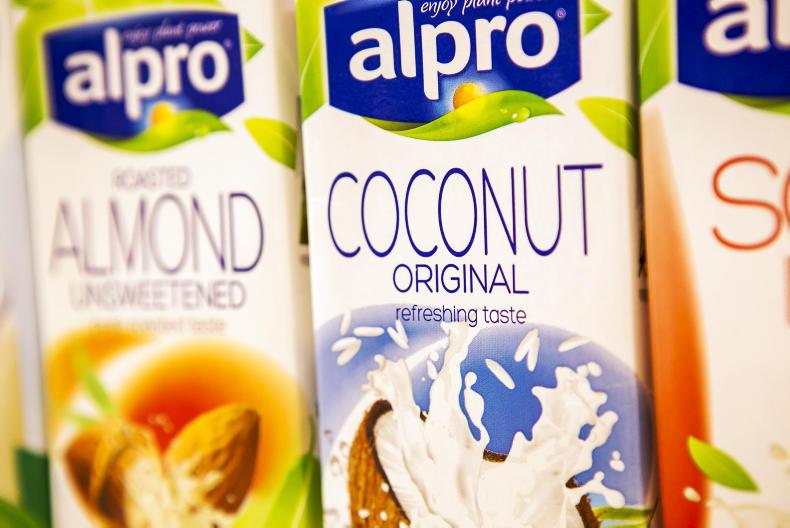The global market for dairy alternatives has increased at 8% annually over the last decade, according to Euromonitor.
In contrast, research presented by Rabobank points out that demand for fluid milk has declined by 5% in western Europe and 3% in the US over the last five years, and a fresh approach is needed to appeal to consumers.
millenials and generation Z are driving the demand for dairy alternatives, and Rabobank highlight the emotional appeal of dairy alternatives who purport to be more environmentally and animal friendly.
Almond dairy alternatives have stolen the lead this year on soya
The global sea change has already been noted by some titans of the dairy industry, with 35% of western Europe’s alternative dairy market made-up of traditional dairy players according to Euromonitor.
Danone completed an acquisition of WhiteWave, a dairy alternative company in April 2017 for $12.5bn.
While the largest co-op in Finland, Valio has recently launched ‘Oddlygood’, a range of oat based dairy alternative products.
Internal competition
The variety of dairy alternatives has also increased, the territory of soya alternatives is being muscled in by oat, almond and even quinoa based alternatives.
Almond dairy alternatives have stolen the lead this year on soya, making up a 76% share of all retail sales of alternative beverages in early 2018.
Are you excited for #worldmilkday? Join us on June 1 as we #raiseaglass to one of the most valuable agricultural commodities worldwide.#milk https://t.co/VqYoWwSPfa pic.twitter.com/zFZkFqInoW
— WorldMilkDay (@WorldMilkDay) May 23, 2018
Soya is battling with consumers who are now wary of its potentially genetically modified status and environmental impact.
Globally however, soya alternatives still lead with a 64% share of the alternative market, followed by almond and coconut with a combined share of 25%, while oats, rise and hazlenuts have less than a 15% share.
The fight-back
However, the particular influence of dairy alternatives over young women of the millennial generation has worried dairy companies, as in the future these women are likely to hold sway over the family shopping trolley.
Traditional dairy products still win on taste and protein for consumers though, according to the research.
Milk also boasts a ‘cleaner’ label
Milk still retains a higher level of protein than dairy alternatives, an issue that many dairy alternatives are struggling with, as increasing protein levels in alternatives, can add an unpleasant taste to the alternative liquids.
Milk also boasts a ‘cleaner’ label, which can appeal to consumers who wish to avoid artificially fortified products.
These issues hold an important appeal for health conscious consumers.
The protection of the definition of ‘milk’, has also been important for the dairy industry, and dairy alternatives have not been permitted to use dairy style names such as ‘milk’ or ‘yoghurt’, since a European Court of Justice ruling in June 2017.
Nationally in Ireland, we have seen a strong campaign from the National Dairy Council (NDC), with billboards and ad campaigns aimed at informing millenials and generation Z, of the importance of dairy in balancing a healthy diet.
The NDC also intend to use a milk van at certain events over the summer that will supply milk based drinks to punters at events such as Rás na mBan, to highlight the important nutritional value of dairy products.
Next up on The Complete Natural Recovery Tour = @Dublin7sFest! Hit the link to find out about the FREE smoothies/recovery fuel on offer, event info & how to get your hands on tickets https://t.co/5YAHs4deZl pic.twitter.com/5o3vw3sreY
— NationalDairyCouncil (@NDC_ie) May 25, 2018
Overall, Ireland has seen a rise in dairy alternatives but milk remains dominant over dairy alternatives.
The Rabobank report suggest that traditional dairy companies should embrace the changing structure of dairy and non-dairy products.
However, it is important to keep the current markets in proportion, with the global dairy retail market estimated to be worth $600bn.
In comparison, the global alternative dairy market, though projected to grow, is worth just $18bn, or 3% of the world market.
Listen: vegan voices: 'Time to shut down the bullshit' - National Dairy Council
Alternative proteins are an opportunity, it’s not going away – Kerry CEO






 This is a subscriber-only article
This is a subscriber-only article









SHARING OPTIONS: